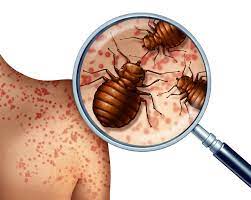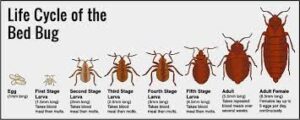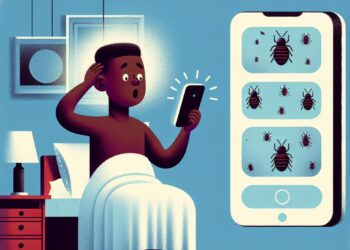Bed bugs are tiny, blood-sucking insects that can make your life miserable if they infest your home. These bugs are notorious for causing itchy bites, and they can be very difficult to get rid of once they’ve taken up residence in your bedding, furniture, or clothing. In this article, we’ll discuss how to identify and control bed bug infestations so that you can get back to sleeping soundly.
Identifying Bed Bugs
The first step in controlling a bed bug infestation is to know what you’re dealing with. Bed bugs are small, flat, reddish-brown insects that are about the size of an apple seed. They are usually found in and around beds, but they can also be found in other furniture, clothing, and even electrical outlets.
One of the most common signs of a bed bug infestation is waking up with itchy, red bites on your skin. These bites may be in a straight line or clustered together and are often found on the arms, legs, and torso. However, not everyone reacts to bed bug bites, so you may not have any visible signs of an infestation.
Another sign of a bed bug infestation is finding small, rust-clouded spots on your sheets, mattress, or walls. These spots are actually bed bug droppings, and they are a sure sign that these pests are present in your home. You may also see shed skins or eggs, which are small, white and oval-shaped.
If you suspect that you have a bed bug infestation, it’s important to act quickly. Bed bugs reproduce rapidly and can quickly spread throughout your home, making them much more difficult to eliminate.

Controlling Bed Bugs
Controlling a bed bug infestation can be a challenge, but it’s not impossible. There are several steps you can take to get rid of these pests and prevent them from coming back.
Clean and Declutter
The first step in controlling bed bugs is to thoroughly clean your home. This means vacuuming carpets and upholstery, washing bedding and clothing in hot water, and scrubbing floors and walls. It’s also important to declutter your home, as bed bugs can hide in cluttered areas.
Use Heat or Cold
Bed bugs are sensitive to temperature, so you can use heat or cold to kill them. You can place infested items in the dryer on high heat for at least 30 minutes, or you can put them in the freezer for several days. You can also use a steam cleaner to kill bed bugs on contact.
Use Pesticides
Pesticides can be effective in controlling bed bugs, but they should be used with caution. Always read the label carefully and follow the instructions. It’s also important to use pesticides that are specifically labeled for bed bugs, as other insecticides may not be effective.
Hire a Professional
If you have a severe bed bug infestation, you may need to hire a professional pest control company. They have access to more powerful insecticides and can use heat treatments to eliminate bed bugs.
Preventing Bed Bugs
Preventing a bed bug infestation is much easier than getting rid of one. Here are some tips to help prevent bed bugs from taking up residence in your home:
Inspect Second-Hand Furniture
If you’re buying second-hand furniture, be sure to inspect it carefully for signs of bed bugs. Look for small, rust-cultured spots, shed skins, or eggs.
Check Hotel Rooms
When you’re traveling, be sure to check your hotel room for bed bugs. Inspect the mattress and bedding for signs of infestation, and keep your luggage off the floor.
Seal Cracks and Crevices
Bed bugs can enter your home through cracks and crevices in walls ,floors, and furniture. Seal these openings with caulk or sealant to prevent bed bugs from entering your home.
Use Bed Bug Proof Mattress Covers
Bed bug proof mattress covers can help prevent bed bugs from infesting your mattress. These covers are designed to be impermeable to bed bugs and their eggs, and they can also protect your mattress from spills and stains.

Be Vigilant
Finally, it’s important to be vigilant and proactive when it comes to bed bugs. Keep an eye out for signs of infestation, and take action immediately if you suspect that you have a problem. The sooner you address a bed bug infestation, the easier it will be to control.
Bed bugs can be a frustrating and difficult problem to deal with, but with the right approach, you can get rid of these pests and prevent them from coming back. By following the tips outlined in this article, you can identify, control, and prevent bed bug infestations in your home. Remember to be proactive and vigilant, and don’t hesitate to seek professional help if needed. With a little effort, you can enjoy a bed bug-free home and a good night’s sleep.
It’s also important to note that bed bugs can be a source of stress and anxiety for many people. The idea of tiny insects crawling around in your bed can be unsettling, and the itchy bites can be uncomfortable and unsightly. If you’re struggling with the emotional toll of a bed bug infestation, it’s important to take care of your mental health as well as your physical environment.
One way to reduce stress and anxiety related to bed bugs is to seek support from friends, family, or a mental health professional. Talking about your feelings and concerns can help you feel less alone and more empowered to take action.
Another strategy is to practice relaxation techniques such as deep breathing, yoga, or meditation. These techniques can help reduce stress and promote feelings of calm and wellbeing.
Finally, it’s important to remember that bed bugs are not a reflection of your cleanliness or hygiene. Anyone can get bed bugs, and it’s not a sign of personal failure. By taking proactive steps to identify and control bed bugs, you’re taking control of the situation and protecting yourself and your home.
In summary
Bed bugs can be a challenging problem to deal with, but with the right approach, you can identify, control, and prevent infestations. By being vigilant, proactive, and seeking professional help when needed, you can enjoy a bed bug-free home and a good night’s sleep. Remember to take care of your mental health as well as your physical environment, and don’t let bed bugs take control of your life.

















